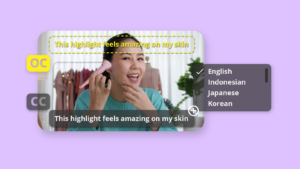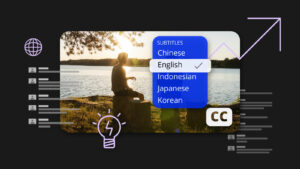Subtitling has become an essential part of video production and distribution, offering accessibility to a broader audience, including those with hearing impairments and non-native language speakers. As video content continues to dominate digital platforms, the demand for high-quality subtitling has grown exponentially. Whether you’re a beginner or an experienced subtitler, this ultimate guide will help you navigate the intricacies of creating effective subtitles.
Why Subtitling Matters
Subtitling is more than just transcribing spoken words into text. It’s about enhancing the viewer’s experience by making content accessible and understandable. Here are a few reasons why subtitling is important:
- رسائی: Subtitles make content accessible to those who are deaf or hard of hearing.
- Global Reach: Subtitles allow non-native speakers to engage with content, broadening your audience.
- SEO Benefits: Search engines can index subtitles, making your content easier to find online.
- Improved Engagement: Subtitles help viewers follow along, especially in noisy environments or when they can’t turn up the volume.
Best Practices in Subtitling
1. Accuracy and Synchronization
Subtitles should accurately reflect the spoken content. This includes not just the words, but also the tone, mood, and intent of the speaker. Synchronization is equally important—subtitles should appear on the screen at the same time the corresponding dialogue is spoken.
2. Readability and Formatting
Readability is crucial in subtitling. Choose a clear, legible font and ensure that the text is large enough to be easily read on any device. Standard white text with a black outline is common, as it contrasts well with most video backgrounds.
Key points to consider:
- Keep each line of subtitle within 32-40 characters.
- Use two lines of text at most, with a gap between them for easier reading.
- Avoid breaking a line in the middle of a word.
It is key that you ensure your subtitles are formatted according to best practices. Use tools like اوریس اے آئی, which automatically generates your subtitles from uploading your videos. With settings like characters per line, it helps you to generate subtitles according to best practices.
3. Timing and Speed
Subtitles should appear long enough for the viewer to read comfortably but not so long that they overlap with the next set of subtitles. A general rule of thumb is that subtitles should remain on screen for 1-3 seconds, depending on the amount of text.
4. Translation and Localization
If you’re creating subtitles in a different language, ensure the translation is accurate and culturally appropriate. Localization involves adapting the content to fit the cultural context of the target audience. This might involve changing idioms, references, or even the tone of the language.
5. Speaker Identification
When multiple characters are speaking, it’s essential to identify who is saying what. Use different colors or add the character’s name in brackets before the dialogue to avoid confusion.
6. Handling Non-Dialogue Elements
Non-dialogue elements like sound effects, background music, or significant noises should be included in the subtitles, especially if they contribute to the scene’s context. For example, [music playing] or [door creaks].
7. Testing Across Platforms
Once your subtitles are complete, test them across different devices and platforms. Subtitles might look different on a smartphone compared to a desktop, so ensure they are legible and properly synchronized everywhere.
Dos and Don’ts of Subtitling
Dos:
- Do use proper grammar and punctuation. Subtitles are a form of written communication and should follow standard language rules.
- Do break subtitles at logical points. If you must split a sentence, do so at a natural pause, such as after a comma or conjunction.
- Do maintain the original tone and intent. If the speaker uses informal language or slang, reflect that in your subtitles.
- Do review and edit. Always review your subtitles for errors in timing, grammar, and accuracy before finalizing.
Don’ts:
- Don’t overload the viewer. Avoid cramming too much information into a single subtitle. If necessary, break it into two parts or simplify the language.
- Don’t use overly complex words. Keep the language simple and easy to understand, even if the spoken dialogue is complex.
- Don’t ignore background noise. Significant background noises should be subtitled to maintain the scene’s context.
- Don’t assume one size fits all. Tailor your subtitles to the target audience, considering factors like language proficiency and cultural nuances.
Tips for Beginner Subtitlers
Starting out in subtitling can be challenging, but with practice and attention to detail, you can master the craft. Here are some tips to get you started:
1. Start with Simple Projects
Begin with short videos or straightforward content. This will allow you to focus on learning the basics of timing, synchronization, and formatting without being overwhelmed by complexity.
2. Use Subtitling Software
Invest in good subtitling software that allows you to create, edit, and synchronize subtitles with ease. Auris AI allows you to start generating subtitles for 15 minutes of content for free, and offers tools and settings that are in accordance to industry best practices. Use these tools to familiarise yourself with the best practices.
3. Watch Subtitled Content
Observe how subtitles are handled in professional productions. Pay attention to timing, formatting, and how non-dialogue elements are treated. This can give you a good sense of industry standards.
4. Practice Regularly
The more you subtitle, the better you’ll get. Practice by subtitling videos in different genres and languages to improve your skills.
5. Seek Feedback
Share your work with others and seek feedback. Constructive criticism can help you identify areas for improvement and refine your subtitling techniques.
6. Keep Learning
Subtitling is an evolving field, with new tools and techniques emerging regularly. Stay updated by participating in forums, watching tutorials, and reading industry blogs.
نتیجہ
Subtitling is a powerful tool that enhances the accessibility and reach of video content. By following best practices, avoiding common pitfalls, and continually refining your skills, you can produce high-quality subtitles that engage and inform viewers. Whether you’re just starting out or looking to improve your existing skills, this guide provides a solid foundation to help you succeed in the world of subtitling.






